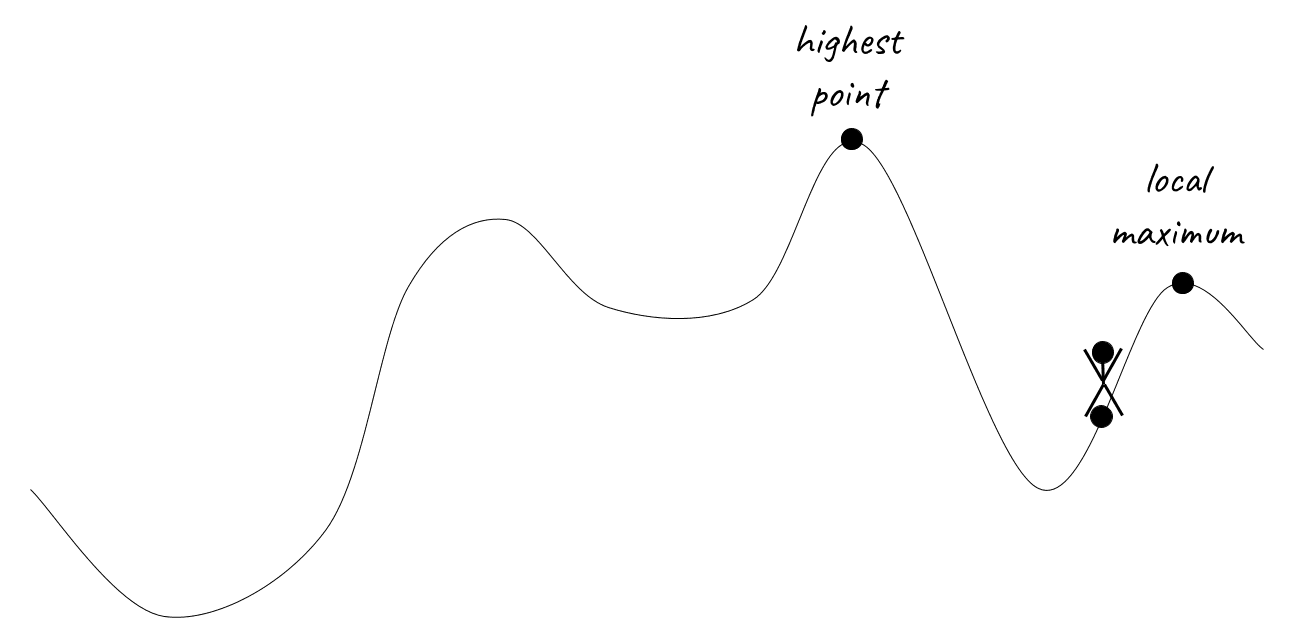Updated: August 21, 2024- 10 min read
Editor's note: The following is an excerpt from Daniel Chak's recently published book, The Product Manager's Guide.
If you don't know where you want to go, then it doesn't matter which path you take.
—The Cheshire Cat; Lewis Carroll, Alice in Wonderland
The Product Manager is tasked with the roadmap for their product. But how do you know what you should be doing in the future, let alone in the present? It’s easy to pick projects to do next based on their adjacency to your current projects. Or to iterate on the current work the next iteration is well understood: just take a few features off the backlog and build in the same way tomorrow as you built yesterday. These options, while safe and easy, are not always the right thing to do. Of course they work for a while, but at some point, they stop working, because the market is in need of a step change rather than an incremental iteration.
Establishing a Product Vision keeps all the team’s projects on a single focused track toward a desired future outcome. In this article, I’ll talk about the related concepts of strategy, vision and insight. I’ll start by discussing what a lack of vision and strategy can feel like, so that you can spot it. Then I’ll talk about what vision and insight are and how you can start to build your muscles in this area.
Random walk: Working without vision
In 1827, the botanist Robert Brown described a phenomenon, now called Brownian motion, based on his observations of the pollen of the plant Clarkia pulchella immersed in water. The pollen seemed to move about completely at random.
“Random walk” is an algorithm that models Brownian motion. You start with a point on a line, a plane, or in 3-dimensional space. At each time step, you randomly assign a new direction for the point to move in. Below is a computer generated image showing a random walk in two dimensions after 25,000 steps. The moving point gets somewhere, but it also gets nowhere in particular. At the time when the motion starts, you have no idea where the point will end up. Certainly, it did not take the shortest path to get there.

When we have no vision, we do something that we know can be done, without much risk, rather than what we know must be done, even if we have no idea yet how to do it. When we have no vision driving our next actions, then we’re not doing much better than a random walk.
Imagine a day where you wake up without a plan. You sit down and respond to the emails that have found their way into your inbox. When it’s time for lunch, you open the fridge and eat whatever is in there. When you take a break, you open an app on your phone. You scroll and scroll down an infinite wall of images and shocking headlines. You go down this rabbit hole, then that rabbit hole, until you realize you’ve been scrolling and clicking for 30 minutes and you don’t even remember where you started. You go back to email. When you’re done for the day, you watch Youtube. As soon as one video is done, another starts immediately. Finally the day is over. How exhausting all that was. Good thing it’s time for bed.
An interesting property of Brownian motion was discovered years later by Albert Einstein. The motion of the pollen is actually not determined by the pollen itself — it’s influenced by the random motion of the water molecules beneath the pollen. At first glance you can imagine the pollen has some agency, choosing to go this way and then that on the surface of the water. In fact, the pollen was just along for the ride, its motions dictated by the capriciousness of the water molecules. The endless stream of emails, the infinite content in scrolling apps, and the videos that play one after another — they are the water upon which we float our boat. As much as we think we’re in control, we’re actually pulled by the undercurrents of what’s around us. When we random walk, we are the pollen, getting taken along for a ride atop these endless streams of distractions.
This style of living or working can be described as “looking busy”, but it is not particularly productive, and it doesn’t get you anywhere in particular. You can random walk over the course of a day, and you can random walk over the course of a lifetime.
Planning at work can succumb to the random walk phenomenon. When we have no vision for where we want to go, this quarter’s goals are often an iteration on last quarter’s goals. Or we pull from a backlog of old acceptable ideas, rather than motivate ourselves toward bold new ones. Or we look to our customers to set our roadmaps for us – scratching their itches but not really making a dent in the universe.
Watch a Product School Webinar from Netflix's Director of Product: Inspiring with a Product Vision
Hill climbing
Hill climbing is a real human condition reduced to mathematical terms.
Imagine a curve that has many peaks and valleys. Now pick a point on that curve at random. Your goal is to move from that point along the curve to the highest point possible.

But there’s a catch. You have to imagine that you literally are the dot on the curve. From the point of view of the dot, you don’t have the luxury of seeing where the highest point on the entire curve is. You can only see what’s immediately to your left or to your right. Your goal is to seek the highest point, so you go in the direction that’s incrementally higher – in this case to the right.
Depending on where you start, you can get stuck at a local maximum instead of finding the globally best outcome. To find the hill with the highest peak, sometimes you need to go downhill for a bit. Sometimes you have to endure many low valleys in order to find the top of the highest mountain.

To see what’s globally best, you need to zoom out. Rather than be a point on a line looking only to the left and to the right, you need to get far enough away to where you can see the big picture. Settling down at the top of a small hill when there are true mountains out there can be very limiting.
When decisions are based on the current situation, they are often incremental in nature. Most of us make decisions based on the options in front of us: left or right, up or down. Beware of making decisions this way, because incremental decisions lead to incremental outcomes. Sometimes you’ve got to zoom out to see where you want to end up. It may be more challenging to get off the hill you’re on and transplant yourself near the highest mountain. But that’s where you’ll find the biggest rewards.
Saying “zoom out” is easy. But having a structured approach to vision and insight requires work. Read on to learn what it takes to do that work.
Vision & Insight
The Merriam Webster dictionary defines vision as “the act or power of seeing”. That is the everyday, pedestrian definition. The follow-on definitions are more useful to us:
the act or power of imagination
a mode of seeing or conceiving; and,
unusual discernment or foresight
When we’re talking about Product Vision, we’re talking about the latter three definitions. We’re referring to "conceiving” of something that is not there yet, but is possible. Looking at what is actual and seeing what is possible requires the power of imagination. Often it requires playing out how the future may unfold with the limited information available today — and that’s foresight.
Visionaries see a possible future as clearly as day, and inspire others to see it too. Product Managers need to take vision one step further. Product Managers must also plot out the path from today’s state to the end state, then lead the team to get from point A to B.
A close cousin to vision is insight. While vision is about seeing, insight is literally about seeing inward. Merriam Webster defines insight as:
the ability to understand people and situations in a very clear way
an understanding of the true nature of something; and,
the act or result of apprehending the inner nature of things or of seeing intuitively
Whereas vision is seeing something that is not there, insight is seeing what is there but which others don’t see. Insightful people see what’s in plain sight, but which others have overlooked or taken for granted.
Insight often involves putting together assets you already have in novel ways to get outcomes that, in hindsight, are obvious. Or finding a way to do much more, with less. Insight often leads to what looks like shortcuts.
People often say, “Teach me how to have vision!” Unfortunately, both insight and vision are hard to teach. They are muscles that must be built over a long time. When someone goes to the gym for the first time and attempts to lift weights, their muscles are not familiar with the movements. Arms tremble under the unfamiliar strain of exercise. After the workout, there is pain, yet no visible change to the muscles. Only after lots of training does the exercise begin to feel natural and the muscles begin to visibly develop.
So too it is with building the muscles of insight and vision. They come only with lots of practice trying on strange ideas and lots of coming up empty. To have vision, you have to think about possibilities from multiple angles, many of which will lead nowhere. You have to look into the future. You have to break things down and put them back together in new ways.
Insight often requires a deep understanding of a domain. And then, it requires having an open mind and a healthy habit of constantly questioning everything that is assumed to be true or unchangeable. What if some dogmas could be challenged and everything could be changed?
Vision is not about incremental changes. Having vision means seeing a version of the world that doesn’t exist yet. In the language of hill climbing, vision is not about moving slightly to the left or slightly to the right. Vision means you can imagine yourself on a completely different mountain that is out of your current view.
Insight is about discerning something “obvious” that everyone else around hasn’t seen yet. That makes the job more difficult: you’ve got to explain your insight to everyone in such a way that it seems obvious once they’ve heard your pitch -- but without it being so simplistic that it seems foolish. “If it’s so simple and obvious, why hasn’t it already been done?”
Once you’ve set your vision, the next step is communicating it in a way that convinces others to work with you to achieve it.
Frameworks & Tools to Innovate
There are a variety of ways to start training the muscle of vision and insight. My book, The Product Manager’s Guide, I take you through frameworks and techniques to unlock innovation. More than that, I take you through the entire journey of being a Product Manager, from start to finish. Check it out, and best wishes for all your journeys in Product!
Updated: August 21, 2024




